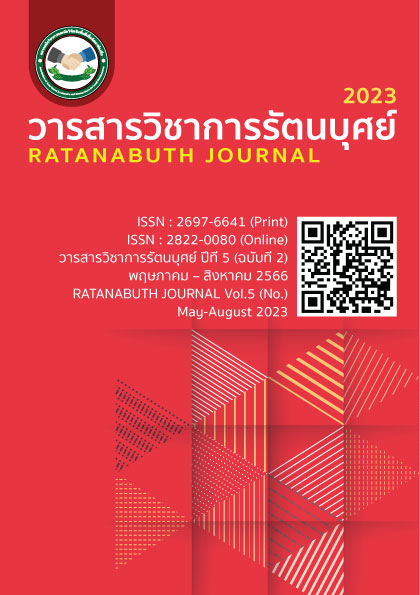A Construction of the Learning Thai Language Diagnostic Test in Strand 5: Literature and Literary Works for Mathayomsuksa 3 Students under the Secondary Educational Service Area Office Sakon Nakhon A Construction of the Learning Thai Language Diagnostic Test in Strand 5: Literature and Literary Works for Mathayomsuksa 3 Students under the Secondary Educational Service Area Office Sakon Nakhon
Main Article Content
Abstract
The purposes of this research were 1) to construct the learning Thai language diagnostic test in strand 5: literature and literary works 2) to assess the quality of the learning Thai language diagnostic test in strand 5: literature and literary works 3) to find a norm of the learning Thai language diagnostic test in strand 5: literature and literary works 4) to write a manual for using of the learning Thai language diagnostic test in strand 5: literature and literary works for Mathayomsuksa 3 Students. The sample consisted of 580 Matthayomsuksa 3 students under the Secondary Educational Service Area Office Sakon Nakhon in the second semester of the 2022 academic year selected by multi-stage random sampling. The research instruments were a test to investigate literary learning issues and the learning Thai language diagnostic test. The mean, percentage, standard deviation, content validity, index of difficulty, index of discrimination, reliability was used for data analysis.
The findings of this research were as follows:
- The learning Thai language diagnostic test in strand 5: literature and literary works for Mathayomsuksa 3 students. The first test analysis was found that the value of the Index of Item Objective Congruence (IOC) was between 0.60 - 1.00. The second test analysis was found that 30 items in all three tests. The difficulty value of the items and the value of the discrimination were between 0.29 - 0.77 and 0.33 - 0.70 respectively. The reliability of the test was between 0.83 - 0.92.
- Summary of learning defects in Thai language on Strand 5: literature and literary works for Mathayomsuksa 3 students. The causes of defects in learning Thai literature are discussed. The students' deficiencies in learning Thai literature as follows: Summaries the content of the literature, literary works and local literary works at even more difficult level. Analyze Thai way of life and values from the literature and literary works read. Summaries knowledge and the ideas from reading and apply them to real life. Memories the recitations prescribed and the verses with their interests.
- The norm of the learning Thai language diagnostic test on Strand 5: literature and literary works for Mathayomsuksa 3 students. The result was found that the score of the learning Thai language diagnostic test on Strand 5: literature and literary works for Mathayomsuksa 3 students was between T15 to T80.
- The manual for using of the learning Thai language diagnostic test in strand 5: literature and literary works for Mathayomsuksa 3 Students. The components of the test manual were the definition of the test, the goal of establishing a diagnostic test, the structure of the diagnostic test, the quality of the diagnostic test, how to administer the test and score it.
Article Details

This work is licensed under a Creative Commons Attribution-NonCommercial-NoDerivatives 4.0 International License.
References
กระทรวงศึกษาธิการ.(2551). เอกสารประกอบหลักสูตรแกนกลาง การศึกษาขั้นพื้นฐาน พุทธศักราช. 2551: แนวปฏิบัติการวัดและประเมินผลการเรียนรู้. กรุงเทพมหานคร: สำนักวิชาการและมาตรฐานการศึกษา สำนักงานคณะกรรมการการศึกษาขั้นพื้นฐาน.
กระทรวงศึกษาธิการ.(2552). หลักสูตรแกนกลางการศึกษาขั้นพื้นฐาน พุทธศักราช 2551. กรุงเทพมหานคร.
กระทรวงศึกษาธิการ.(2552). ตัวชี้วัดและสาระการเรียนรู้แกนกลาง กลุ่มสาระการเรียนรู้ ภาษาไทย ตามหลักสูตรแกนกลางการศึกษาขั้นพื้นฐาน พุทธศักราช 2551.กรุงเทพฯ:โรงพิมพ์ ชุมนุมสหกรณ์การเกษตรแห่งประเทศไทย จำกัด.
จิตต์นิภา ศรีไสย์. (2555). วรรณคดีและวรรณกรรม ม.3. กรุงเทพมหานคร: บริษัทพัฒนาคุณภาพ วิชาการ (พว.) จำกัด.
ชัตสุนีย์ สุนธุสิงห์. (2532). วรรณคดีทัศนา. กรุงเทพมหานคร: โครงการตำราคณะอักษรศาสตร์ จุฬาลงกรณ์มหาวิทยาลัย.
เถกิง พันธุ์เถกิงอมร. (2528). หลักการวิจารณ์วรรณคดี. นครศรีธรรมราช: โครงการตำราและเอกสารวิชาการ วิทยาลัยครูนครศรีธรรมราช.
บุญชม ศรีสะอาด. (2523). การสร้างแบบทดสอบวินิจฉัย. กรุงเทพมหานคร โรงพิมพ์กรุงเทพการพิมพ์.
บุญธรรม กิจปรีดาบริสุทธิ์. (2553). สถิติวิเคราะห์เพื่อการวิจัย. พิมพ์ครั้งที่ 5 .กรุงเทพมหานคร: จามจุรีโปรดักท์.
ไพศาล วรคำ. (2558). การวิจัยทางการศึกษา. พิมพ์ครั้งที่ 7. มหาสารคาม: ตักสิลาการพิมพ์.
ลมโชย ด่านขุนทด. (2544). การพัฒนาผลสัมฤทธิ์การอ่านภาษาไทยโดยใช้แบบฝึกทักษะการอ่าน สำหรับนักเรียนชั้นมัธยมศึกษาปีที่2 โรงเรียนสมเด็จพิทยาคม อำเภอสมเด็จจังหวัดกาฬสินธุ์. วิทยานิพนธ์ ศษ.ม. ขอนแก่น: มหาวิทยาลัยขอนแก่น.
ล้วน สายยศ และอังคณา สายยศ. (2538). เทคนิคการวิจัยทางการศึกษา. พิมพ์ครั้งที่ 4.กรุงเทพฯ:สุวีริยาสาส์น.
วิภา กงกะนัน. (2533). วรรณคดีศึกษา. พิมพ์ครั้งที่ 2. กรุงเทพมหานคร : ไทยวัฒนาพานิช.
สมนึก ภัททิยธนี. (2549). การวัดผลการศึกษา. กาฬสินธุ์ : ประสานการพิมพ์.
สาคร สียางนอก. (2556). การพัฒนาแบบวัดทักษะกระบวนการทางคณิตศาสตร์ สำหรับนักเรียนชั้นมัธยมศึกษาปีที่ 3. วิทยานิพนธ์ ค.ม. มหาสารคาม: มหาวิทยาลัยราชภัฏ มหาสารคาม.
สิริยา เวียงนนท์. (2551). การศึกษาสภาพปัญหาการจัดการศึกษาของโรงเรียนเอกชนสอนภาษาจีนในกรุงเทพมหานคร. วิทยานิพนธ์ ศศ.ม. (การบริหารการศึกษา).กรุงเทพฯ : บัณฑิตวิทยาลัย มหาวิทยาลัยสยาม.
อานนท์ หล้าหนัก. (2552). การสร้างแบบทดสอบวินิจฉัยวิชาภาษาไทยสำหรับนักเรียนชาวไทยภูเขาเผ่ากะเหรี่ยงชั้นประถมศึกษาปีที่2. การค้นคว้าแบบอิสระศึกษาศาสตรมหาบัณฑิตบัณฑิตวิทยาลัยมหาวิทยาลัยเชียงใหม่.


